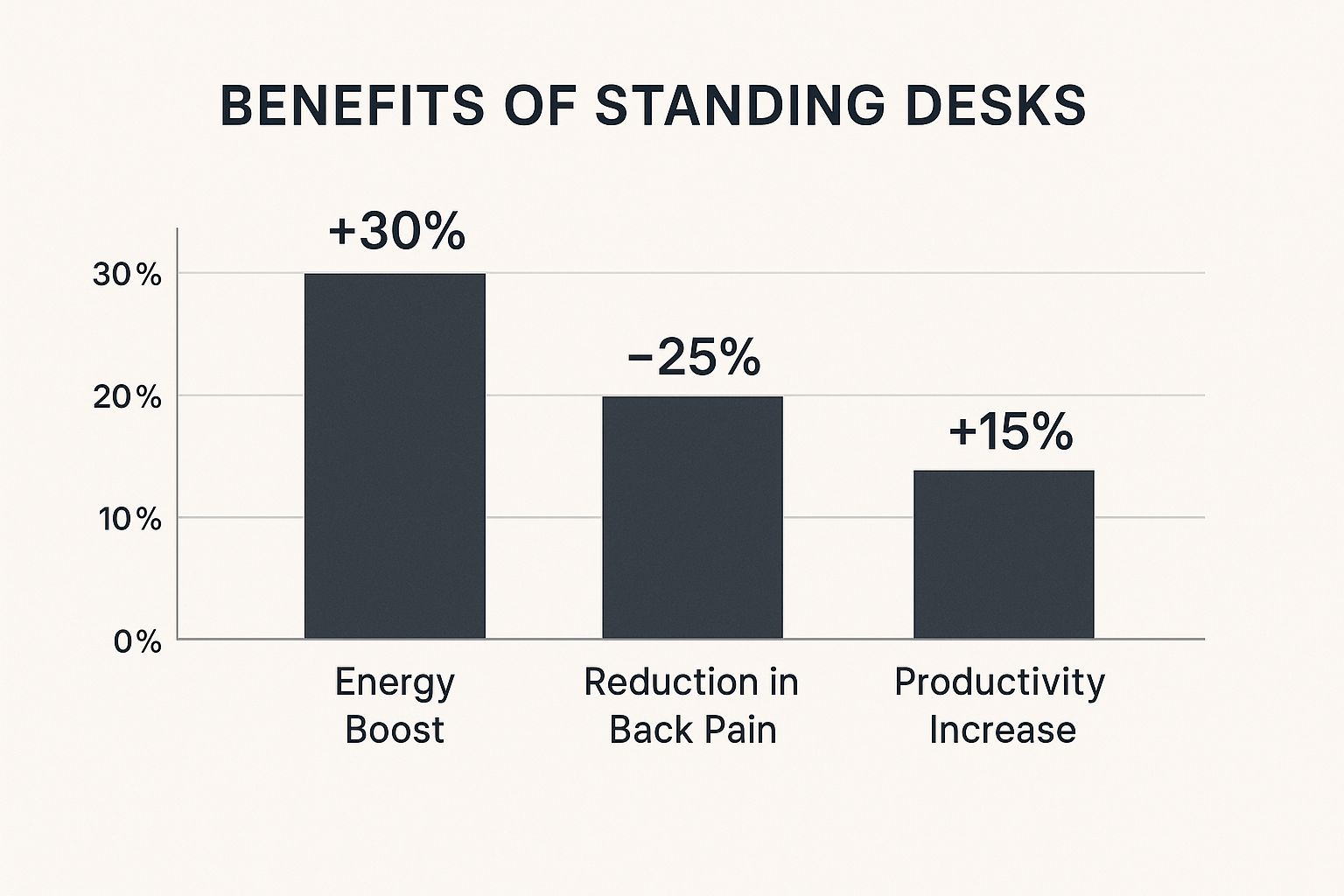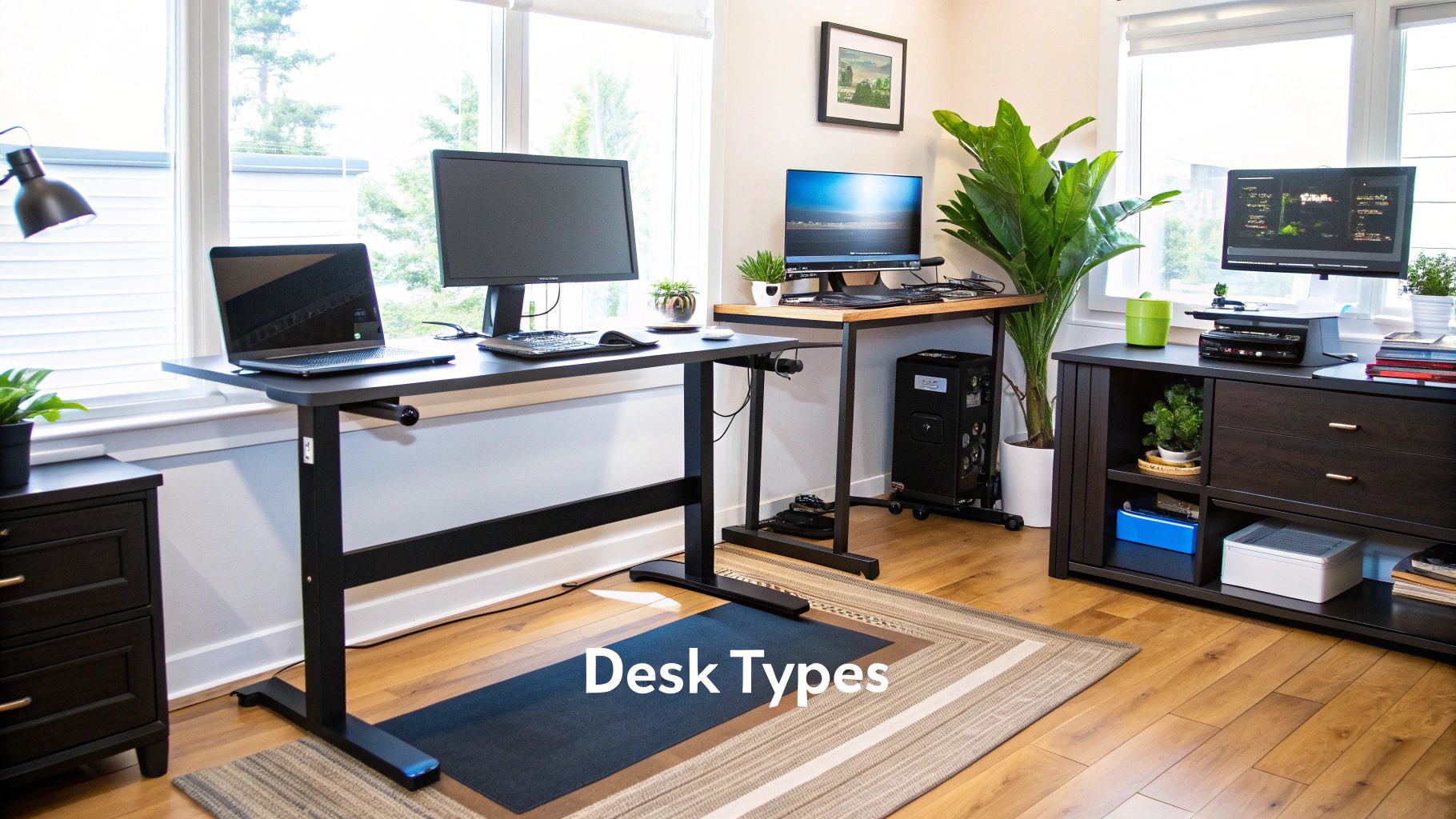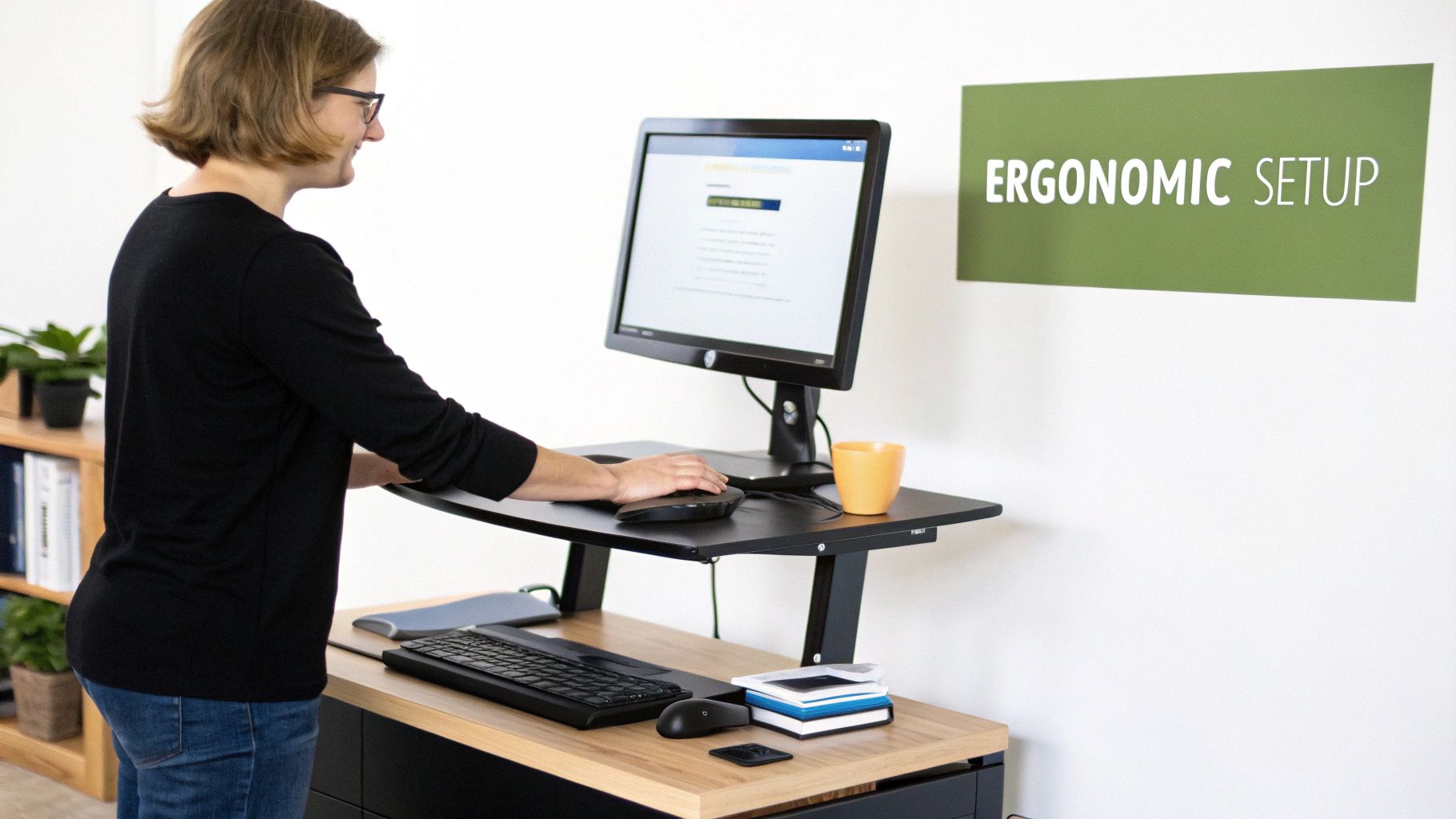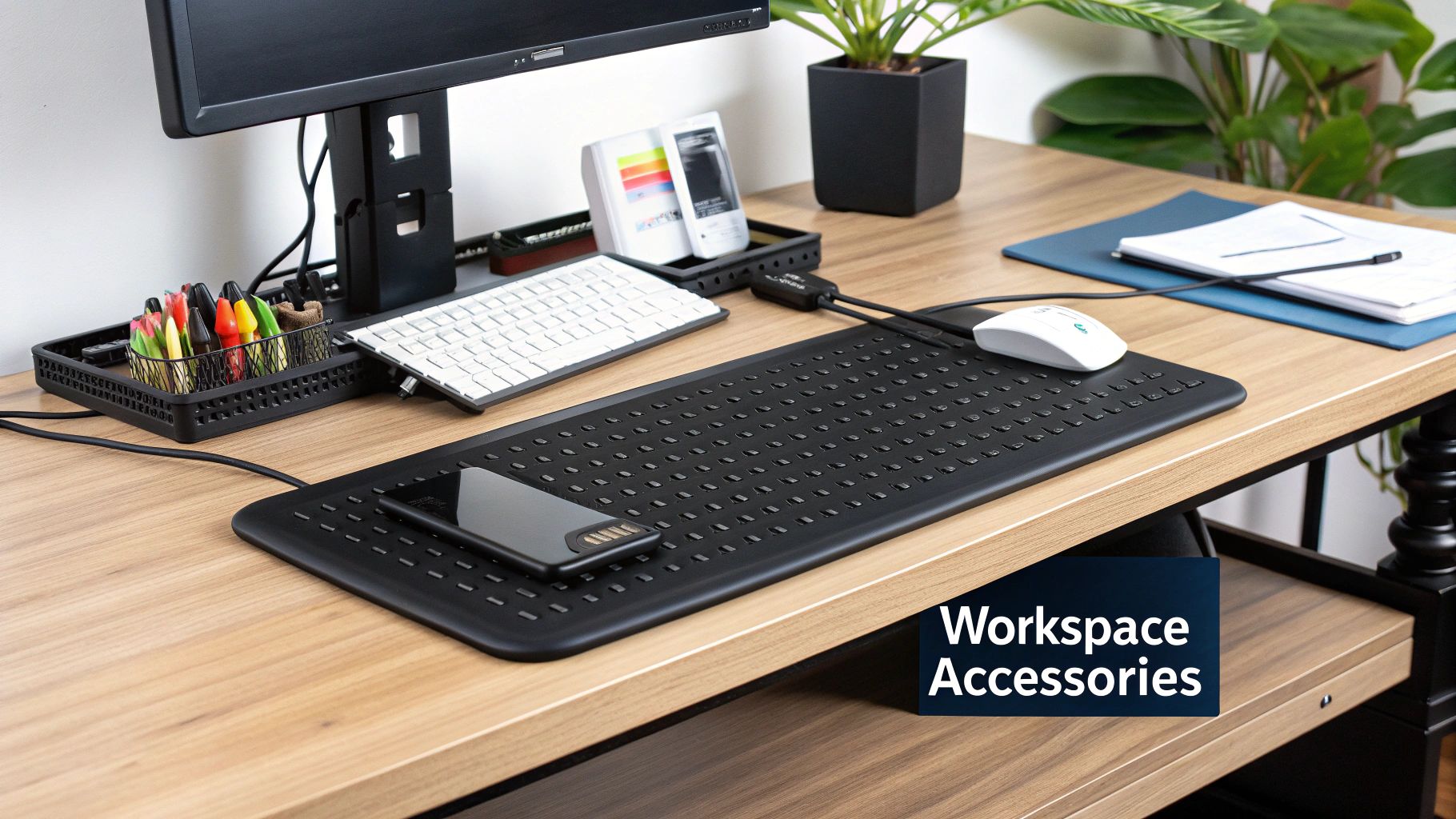Why Your Standing Desk Setup Actually Makes Or Breaks Everything
Setting up a standing desk isn't just about slapping some furniture together; it's about crafting a workspace that truly boosts your well-being and productivity. This is where the magic happens, or doesn't, and surprisingly, it's where so many people go wrong. I've chatted with tons of standing desk users, and the same story keeps popping up: initial discomfort leads to the desk becoming a glorified clothes rack. It's rarely the desk itself; it’s almost always the setup. This often-overlooked detail is the difference between becoming a standing desk evangelist or just another disappointed buyer. Want to learn more about the benefits? Check this out: Standing Desk Benefits Explained.
Think about the psychology at play. Some setups just feel right from the start, while others feel like a chore. Imagine your monitor is too low. You're constantly craning your neck, which inevitably leads to headaches. Or maybe your keyboard is at a weird angle, and your wrists are aching before lunch. These seemingly small positioning mistakes can create a negative association with standing, making you subconsciously avoid using the desk.
It's no secret that standing desks are gaining popularity for their health benefits and ergonomic design. In fact, the market is projected to reach a whopping USD 11,064.6 million by 2030. This shows just how many people are looking for a better workspace experience! Discover more insights about the growing standing desk market.
Here’s another key point: what works for one person might be a disaster for another. We all have different bodies, work styles, and even pre-existing conditions. Copying someone else's “perfect” setup is a recipe for frustration. I learned this the hard way by mimicking my taller friend's configuration. The result? Nagging shoulder pain. I had to go back to the drawing board and adjust everything—desk height, keyboard tray, monitor placement—until it felt right for me. This personalization process is the real key to long-term comfort and success with a standing desk. Don't be afraid to tweak and experiment!
Finding Your Perfect Standing Desk Match
Picking the right standing desk can totally change your workspace for the better, but choosing the wrong one? Let's just say it can be a real headache (and a waste of money). So, let's ditch the marketing jargon and get real about the pros and cons of different standing desk types – based on what actual users experience.

This infographic highlights some serious perks: a +30% energy boost, -25% reduction in back pain, and a +15% increase in productivity. These are pretty compelling reasons to consider a standing desk, right?
Exploring Your Options
Desk converters are a popular choice. They’re generally affordable and easy to plop onto your existing desk, which is a huge plus. I've tried a few of these, and while the setup is super simple, some can feel a bit wobbly compared to a dedicated standing desk. The two-tiered setup can also be a bit awkward. Still, if you’re tight on space or budget, a converter is a great entry point.
A full standing desk is a bigger investment and requires more room, but it offers rock-solid stability and a cleaner look. It's also worth thinking about what ergonomic office accessories you’ll need to complete your setup.
Then there are smart desks with memory settings. These are getting more and more popular. Being able to save your preferred heights is super handy, especially if you share your desk or frequently switch between sitting and standing. The downside? They’re usually pricier.
To give you a better sense of the landscape, converters are the most common type right now, but Bluetooth standing desks are the fastest-growing category. This tells me people are craving smarter workspaces. Companies like Steelcase, Ergotron, and Herman Miller, are leading the charge in this area. You can find more insights on the standing desk market here. Also, this article on Standing Desk Best Practices is a worthwhile read.
To help you choose, I've put together a table summarizing the pros and cons of each type of standing desk, based on my own experience and what I’ve seen from others.
To help you navigate this, I’ve put together a quick comparison table:
Standing Desk Types: Real-World Comparison Honest assessment of different standing desk types based on actual user experiences and practical considerations
| Desk Type | Setup Time | Price Range | Best For | Real Pros | Hidden Cons |
|---|---|---|---|---|---|
| Converter | < 30 minutes | $100 - $400 | Budget-conscious users, small spaces | Easy setup, affordable, portable | Can be wobbly, two-tiered design can be awkward |
| Full Standing Desk | 1-2 hours | $300 - $1500+ | Dedicated workspace, stability is key | Sturdy, clean aesthetic, customizable | Requires more space, higher initial investment |
| Smart Desk | 1-2 hours | $500 - $2000+ | Multiple users, frequent sit-stand switching | Programmable height settings, advanced features | Most expensive option, potential technical issues |
This table highlights the key differences between the main types of standing desks available. Converters are a quick and inexpensive way to try out standing, while full standing desks offer a more permanent and stable solution. Smart desks provide extra convenience but come at a higher price.
Finding What Works for You
At the end of the day, the best standing desk is the one that best fits your needs. Think about your budget, the space you have, and how you plan to use the desk. Don’t be afraid to experiment and tweak your setup. It might take a few tries to find the sweet spot between comfort and functionality, but trust me, it’s worth it.
Assembly Without The Frustration

Let's be real, standing desk instruction manuals can be a nightmare. They often feel written by Martians who've never even seen Earth furniture. So, ditch those cryptic diagrams. Let's talk practical assembly tips that actually work. Trust me, this is the stuff I wish I knew before my first standing desk rodeo.
Tools of the Trade (And Which Ones to Skip)
Most manuals give you a massive tool list. Honestly, you won't need half of it. A decent screwdriver, the included Allen wrench, and maybe a small hammer are your core crew. Personally, I swear by a magnetic screwdriver. It's a lifesaver for those tiny screws, keeping them from vanishing into the carpet dimension. Oh, and an extra set of hands for bigger desks? Game-changer.
Having someone there to help, particularly for the large components or awkward lifting, can be incredibly helpful.
The Assembly Order That Saves Your Sanity
One of the biggest pains is realizing you’ve assembled something in the wrong order. Ask me how I know. My advice? Lay everything out first. Double-check you have all the parts. Then, loosely assemble the frame before cranking down any bolts. This gives you wiggle room to adjust without having to backtrack and dismantle half the desk (yes, I've been there).
This simple approach saves a lot of potential headache and frustration.
Solo Mission or Team Effort?
Setting up a smaller standing desk converter? Totally doable solo. But for the larger, heavier desks? Grab a buddy. It's safer, easier, and prevents potential damage. Lifting the desktop onto the frame, for example, is way less risky with two people. Plus, it’s always more fun to celebrate (and occasionally commiserate) with a friend.
You can either go through the process solo or have a friend come over to help. Choose whatever works best for your situation.
Troubleshooting When Things Go Sideways
Look, sometimes things just don't go as planned. If you hit a snag, don't panic. Take a breath, double-check those instructions, and if you’re still stumped, don't hesitate to call customer support. They’ve seen it all and can probably get you back on track. Remember, setting up your standing desk should be exciting, not a stress-fest. With a little patience and these practical tips, you’ll be enjoying your new setup in no time.
Getting The Ergonomics Right From Your First Day

So, you've got your standing desk. Now for the real work – making it work for you. Generic advice online often misses the mark because everyone's different. Let's ditch the one-size-fits-all and get your setup truly personalized. Even seemingly small things like cable management can make a big difference in your overall setup. Clean cabling keeps things organized and efficient. If you're looking for some pro tips, check out this guide on stage cable management. You might be surprised how much it helps!
Listening To Your Body, Not The Charts
Forget rigid charts and generic measurements. Your body is the best guide. Start with a desk height that feels comfortable and then really pay attention to how you feel after a while. Are your shoulders creeping up towards your ears? Do your wrists feel achy? These are your body’s whispers telling you to adjust something. I even noticed my ideal desk height changed depending on my shoes! Flats meant lowering the desk a bit compared to when I wore heels. It's all about those little tweaks and listening to what your body tells you.
For more tips on proper standing desk posture, check out this helpful article: How To Properly Stand At A Standing Desk.
Positioning For Peak Performance
Your workspace is like a little ecosystem – everything's connected. Your monitor should be roughly an arm's length away, and the top of the screen should be at or slightly below your eye level. This helps prevent neck strain. Position your keyboard so your elbows are at a comfy 90-degree angle, which is key for happy wrists. Don't forget the mouse! Make sure it's close enough to avoid any reaching. These little adjustments can make a huge difference in your comfort and prevent long-term problems.
To help visualize a personalized setup, I've put together some guidelines:
Personalized Ergonomic Setup Guidelines: Customized positioning recommendations based on individual height ranges and work requirements.
| User Height | Starting Desk Height | Monitor Distance | Screen Top Position | Keyboard Angle |
|---|---|---|---|---|
| Under 5'4" | 38-40 inches | 20-24 inches | Slightly below eye level | Negative tilt if needed |
| 5'4" - 5'8" | 40-42 inches | 24-28 inches | At or slightly below eye level | Neutral or slight negative tilt |
| 5'9" - 6'2" | 42-44 inches | 28-32 inches | At eye level | Neutral |
| Over 6'2" | 44-46 inches | 32-36 inches | Slightly above eye level | Positive tilt if needed |
This table offers starting points. Remember to adjust based on your individual comfort!
The Dynamic Desk: Adjusting Throughout The Day
Here's the thing: your “perfect” desk height isn’t set in stone. It changes throughout the day. You might want it a little higher in the morning when you're feeling energized and then lower it in the afternoon as you start to get tired. Don't be afraid to adjust it several times a day! It's all about finding what feels best right now. Even your mood can affect your posture, so tune in to your body and adjust as needed. This dynamic approach is crucial for staying comfortable and avoiding stiffness.
Real-World Examples: Finding What Works For You
Everyone’s different. My friend, a graphic designer, cranks her desk up high when she's sketching on her tablet, but she lowers it for detailed computer work. Another friend, a programmer, keeps his desk pretty low to minimize wrist strain during those marathon coding sessions. It's all about those personalized tweaks that make all the difference! By paying attention to your own needs and making adjustments as you go, you’ll create a workspace that not only supports your work but also contributes to your overall well-being.
Building Your Standing Stamina The Smart Way

Let's be real, nobody successfully transitions to a standing desk by immediately standing for eight hours a day. In fact, that's a surefire way to end up right back in your old chair, and probably with an achy back to boot. Building standing stamina is a gradual process.
The Gradual Transition: A Marathon, Not a Sprint
Think of it like training for a marathon. You wouldn’t try to run 26.2 miles on day one, right? The same logic applies here. Begin with shorter periods of standing—maybe 30 minutes—with sitting breaks in between. Slowly increase your standing time as you feel your body adapting. It’s not about forcing anything; it's about discovering what's sustainable for you.
I personally started with just an hour total, split into two 30-minute sessions. Over a few weeks, I gradually bumped up my standing time until I could comfortably stand for a good chunk of my workday. Everyone is different, so listen to your body and adjust as needed.
Discomfort vs. Pain: Knowing the Difference
Expect some initial discomfort. Your legs might get a little tired, or your back might feel stiff. This is perfectly normal—it's just your body adjusting to a new way of working. Sharp pain, on the other hand, is a signal to stop. If you experience any shooting pains, numbness, or persistent discomfort, don’t push through it. Sit down, take a break, and reassess your setup. You might find some helpful tips in this article on how to avoid injuries from poor ergonomics.
Finding Your Rhythm: Matching Your Work Style
There’s no one-size-fits-all approach to standing desk usage. A programmer might find they prefer longer sitting stretches for deep work, while a designer might stand more frequently while sketching or brainstorming. If you're working with multiple monitors, check out these tips on optimizing a dual monitor setup. As a writer, I find that switching between sitting and standing helps keep my energy levels up and my mind focused. Experiment and find what works best for your workflow.
It's interesting to note that the standing desk market is projected to reach $12.01 billion by 2025. This shows just how many people are searching for ergonomic solutions! You can find more info on the market growth here. Remember, your standing desk journey is your own. Don’t compare yourself to others. Focus on finding a balance that supports both your work and your well-being.
Perfecting Your Setup For Long-Term Success
Setting up your standing desk is just the first step. The real magic happens when you start tweaking and refining it over time. Those who truly love their standing desks are constantly making little adjustments, figuring out what works best for their bodies and work habits. It’s a journey, not a destination. Think of it like breaking in a new pair of shoes – you adjust the laces, maybe add an insole, until they fit just right.
Cable Management: Taming the Wire Jungle
Let's be honest, a tangled mess of cables under your desk can be a real eyesore. I learned this the hard way! My initial "I'll deal with it later" approach quickly spiraled into a cable jungle. Now, I'm a big believer in cable ties and those little adhesive clips. I even run the cables along the underside of the desk to keep them completely out of sight. Trust me, a clean, organized space does wonders for your focus and your sanity.
Lighting: Bright Ideas For Eye Comfort
Proper lighting is another game-changer. I used to get terrible eye strain, and it took me way too long to realize my overhead light was the culprit. The glare on my monitor was a killer. Now, I use a desk lamp with adjustable brightness and color temperature. I position it behind my monitor, so I get focused light without the annoying glare. I also added a bias light – a small light strip behind the screen – which really helps reduce eye fatigue during those long work sessions.
Check out our guide on adjustable height desks for additional insights: Adjustable Height Desk: Mount-It.
Accessories That Actually Matter
Don't get sucked into buying every trendy desk accessory. Some things are genuinely useful, like a good quality anti-fatigue mat. Seriously, your feet will thank you. I also sprung for an ergonomic footrest, which lets me shift my position and keeps my legs from getting stiff. These small investments make a huge difference in your overall comfort and can prevent long-term issues down the road.
The US market for standing desks is exploding, as more and more businesses prioritize employee well-being and the ergonomic benefits become clearer. The market hit $1,687.4 million in revenue in 2024 and is projected to reach $2,112.4 million by 2030. That's a lot of standing desks! Dive deeper into the US standing desk market.
Adapting To Change: Seasonal Shifts and More
Your perfect setup isn't a one-and-done deal. You’ll want to adapt it to the changing seasons and your evolving needs. In the winter, I put a small space heater under my desk to keep my toes warm. In the summer, a small fan does the trick. It's all about finding those little tweaks that make your workspace comfortable year-round.
By paying attention to these details, you can transform your standing desk from just a piece of furniture into a truly personalized and productive workspace. Ready to create your ideal setup? Explore the ergonomic solutions available at Mount-It!
